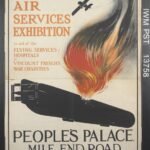
This advertisement, which appeared in the East Ham and South Essex Mail on 2 November 1917, excited my curiosity. An exhibition of German aircraft… held in the East End of London… just after the Harvest Moon raids? I’m there! Or would be if time travel was a thing. As it’s not (yet…) I’ll have to go via the BNA instead.
The exhibition’s formal name was the Air Services Exhibition, and it was held at the People’s Palace in Mile End between 1 and late November 1917; it was originally due to end on 19 November, but as of 15 November 100,000 people had passed through the doors, so it was extended for ‘a further period’.((Westminster Gazette, 15 November 1917, 7.)) In fact I can’t find much mention of it in late November so maybe it did close as originally advertised.
This was in fact the exhibition’s second London incarnation: it had originally opened on 24 January 1917 at the (considerably swankier, I’d imagine) Grosvenor Gallery in New Bond Street. It then moved to Birmingham, Coventry (both April), Liverpool, Manchester (both May), Glasgow (June), Edinburgh (July), Dundee (August) and Leeds (September). Then, after its London return season, the exhibition travelled across the Irish Sea to open in Dublin (December) and finally Belfast (January 1918). There was some talk of it going to Italy after this but I’ve found no evidence that this happened.((Mail (London), 3 April 1918, 6.))

The driving force behind the exhibition was Kathleen Pelham-Burn (above), Lady Drogheda, an aviation-obsessed socialite who as early as 1914 had been referred to as a ‘Flying Countess’, as she had made ‘several flights at Hendon’.((Liverpool Echo, 23 June 1914, 4.)) Just after the war’s end, the Tatler described her as ‘a very keen airwoman, having made many flights as a passenger, did excellent service for the war funds with her aircraft exhibition, with which she travelled almost all over England and Ireland, making a very substantial sum of money’, which was presumably why she was awarded CMG in January 1919.((The Tatler (London), 18 December 1918, 11; London Gazette, 7 January 1919, supplement, 449.)) Lady Drogheda was no mere figurehead: the Yorkshire Post wrote that while the exhibition ‘certainly deserves all that is being said in its praise’,
Yet it owes not little to Lady Drogheda’s own gifts as a ‘showman.’ She rather takes a pride in having been very largely her own advertising agent, and, on occasion, even her own bill-sticker. She admits that this work did much to popularise her exhibition in the shipbuilding centres of the North-East Coast and in other places, where she also had frequent talks with the workers of both sexes.((Yorkshire Post (Leeds), 2 November 1917, 4.))
At, or rather over, Dublin, she even dropped leaflets out of an aeroplane to publicise the exhibition’s opening.((Sunday Pictorial (London), 23 December 1917, 2.)) When it reopened at London, an aeroplane performed ‘all manner of “stunts,” including “looping,” to the great delight of the crowds below’, as a brass band marched through the City.((The Sketch (London), 14 November 1917, x.)) A columnist for the socialist newspaper Justice apparently didn’t notice the aeroplane, but did hear and see the band:
What was the music that I heard approaching? It did not now sound quite like a military band. But it was musical enough to make everyone turn and go in the direction whence the sound proceeded. It was not a military band at all, marching at the head of a company. It was a brass band, the performers dressed in quasi-military uniforms, in a wagonette advertising an exhibition of enemy aircraft at the People’s Palace! What a sell!((Justice (London), 8 November 1917, 3.))
So what were they actually promoting? I’ll look at the exhibition’s exhibits in a later post.
Image sources: East Ham and South Essex Mail; The Tatler.
![]() This work is licensed under a Creative Commons Attribution-NonCommercial-NoDerivatives 4.0 International License.
Permissions beyond the scope of this license may be available at http://airminded.org/copyright/.
This work is licensed under a Creative Commons Attribution-NonCommercial-NoDerivatives 4.0 International License.
Permissions beyond the scope of this license may be available at http://airminded.org/copyright/.





